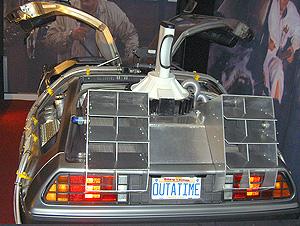The science of time travel
In the movie “Back to the Future,” the time machine was a souped up DeLorean (Image by Flickr user AdamL212 (cc: by-nc-sa))
This story is adapted from a broadcast audio segment; use audio player to listen to story in its entirety.
David Goldberg teaches physics at Drexel University. In his book, “A User’s Guide to the Universe,” he explains how time travel might be possible.
In this interview with “Studio 360’s” Kurt Andersen, he says the skeptics are wrong: “It’s certainly within the realm of what we know about how the universe works.”
Kurt Andersen: You’re a reputable scientist; yet here you are, willing to talk about this not very reputable subject of time travel. How did your interest in this subject begin?
David Goldberg: There was a professor of mine in graduate school, a guy by the name of Rich Gott. He wrote a book called “Time Travel in Einstein’s Universe,” and he and I would have these long conversations — and we continue to — and he really got me thinking about, not just the sci-fi part, but … also how one would go about building a time machine, and talking about the real science behind it.
Andersen: There’s recent work by theoretical physicists over the last decade or so, that make time travel seem even more plausible as a possibility, theoretically.
Goldberg: The big physics that describes time is Einstein’s Theory of General Relativity, and that’s the one developed in 1915. And basically, as it’s normally purported, is that space is bent, time is bent, and they’re very much like one another.
So, time travel models are very much a real area of physical research, and generally they involve warping time, usually with big masses, by warping space. Fly around fast enough and you can bend enough and manipulate enough energy, you can do it.
Andersen: And how does that actually happen at some indeterminate time in the future?
Goldberg: My favorite model for time machines is something that was designed by Kip Thorne and some of this students in the 1980s. He’s a physicist. And the basic idea involves something called wormholes — a staple of sci-fi. The basic idea is space is bent, you go in one end, you come out the other; potentially in a very, very different part of space. Never seen one yet, but people have ideas about how we might go about making them.
So, that’s how you travel through space. It’s a simple matter, then, to travel through time. You take one mouth of the wormhole, you fly it around for a while at speeds close to the speed of light, and you bring it back. And then, if you’ve ever heard of the twin paradox, the special relativity, the idea is if you’ve been flying around, you age less than the stay-at-home twin. So you go in the mouth that’s been flying around and you come out the other end, and you’re in the past by a predetermined amount. It’s fixed.
Andersen: Some of the naysayers and doubters say that the amount of energy required to manipulate these wormholes for humans to use are impossibly immense. Is that a big problem?
Goldberg: Impossible is a very strong word. I would say you and I, after the show, I don’t suggest we get together and try to do this, but it’s not outside the realm of possibility. We think about what will eventually be within our control. Splitting the atom was something that seemed impossible, an impossible amount of energy, at not too long ago in the past. The idea that we someday might be a super civilization that’s able to create large scale black holes or wormholes or comic strings — which is another way of making time machines — is not impossible. It’s certainly within the realm of what we know about how the universe works.
Andersen: I think I get wormholes as this kind of shortcut through time or space. But it sounds so abstract. I wonder: Is there a certain kind of physicist who rolls his or her eyes when you start talking about time travel?
Goldberg: Yes, they are very serious people. Stephen Hawkin is famously a time travel doubter. But that’s only because, of course, people don’t have a proof of concept.
Andersen: His big problem is this: Why aren’t there people from the future among us now?
Goldberg: That’s a possibility, although the time machine we’ve just described is a good answer for that. Since you need to already have made the time machine before you can use it, you can’t ever go back before it was built.
PRI’s Peabody Award-winning “Studio 360 with Kurt Andersen” from WNYC is public radio’s smart and surprising guide to what’s happening in pop culture and the arts. Each week, Kurt Andersen introduces you to the people who are creating and shaping our culture. Life is busy — so let “Studio 360” steer you to the must-see movie this weekend, the next book for your nightstand, or the song that will change your life.
